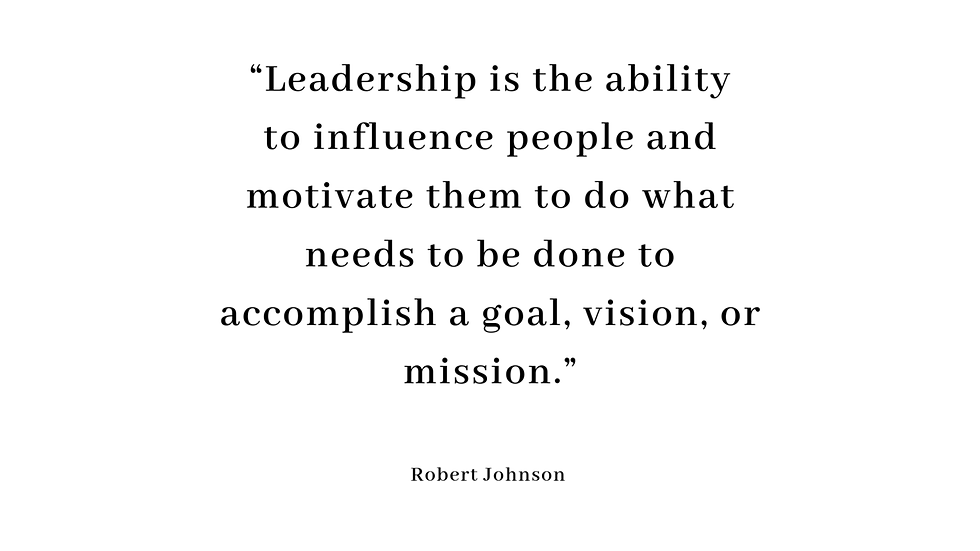Leadership Cannot Exist Without Influence, Here's Why
- Gifford Thomas

- Jun 23, 2019
- 3 min read

At the height of recession in 2008, Gerry Anderson CEO of DTE Energy required his people to reach for something more besides their own self targets and preservation; but deep in his heart he knew his people was not inspired according to the Harvard Business Review. Employees couldn’t seem to break free of old, tired behaviors; they weren’t bringing their smarts and creativity to their jobs, and they weren’t performing up to their potential.
What turn things around! The new leader infused the core purpose of the company in the everyday lives’ of each employee. Before the recession, Anderson considered purpose as empty and simplistic rhetoric. But having run into a dead end in figuring out how to make his own organization thrive; Anderson was reexamining some of his basic assumptions about management, and he was open to what a purpose-driven organization can do to inspire his team.
Anderson made a video that articulated his employees’ higher purpose. It showed DTE’s truck drivers, plant operators, corporate leaders, and many others on the job. Anderson described the impact of their work on the well-being of the community—the factory workers, teachers, and doctors who needed the energy DTE generated.
The first group of professional employees to see the video gave it a standing ovation. When union members viewed it, it moved them to tears. Never had their work been framed as a meaningful contribution to the greater good. The video brought to life DTE’s new statement of purpose: “We serve with our energy, the lifeblood of communities and the engine of progress.”
The profound difference between management and leadership is influence

You cannot be a leader if you cannot influence others and it’s never about fear, intimidation or manipulation. People are human beings, not machines, mechanical parts, or assembly lines. They respond best when they are treated like human beings, they work best when they have a voice in how the work is done, and they remain loyal and engaged when they feel respected, trusted, well informed, and cared for. That’s why the best managers also lead, and they lead through the social and emotional approaches to influencing, not just the rational approaches according to Bennis and Nanus.
Values Driven

One of the most successful approaches to leading others is to lead from a strong set of values according to Naphtali Hoff, PsyD. Values are the core components of a person’s deepest beliefs; when a leader takes the time to identify their deepest values, that leader is likelier to make satisfying choices and remain consistent in their actions and choices. Leaders influence their people by articulating and living their values; when this happen their team is more inclined to support the direction and purpose of the company.
Vision

Leaders mobilize people around a compelling vision of the future. They show people what’s possible and motivate them to make those possibilities real. They energize and focus people in ways that fulfill their dreams, give them a sense of purpose, and leave them with a profound sense of accomplishment when the work is done.
Organizations provide its managers with legitimate authority to lead, but there is no assurance that they will lead effectively. As a manager, you are the de facto leader, but what prevents the manager from becoming a leader is their qualities and their ability to influence their team to perform at their very best. An essential factor in leadership is the capacity to influence; the ability to motivate and inspire others to take action; this is the distinguishing factor between a leader and a manager. The best leaders are those who can successfully influence up, down and across the organization according to Michelle Eggleston.
It’s not telling others what to do, it’s about inspiring your people to believe in themselves to do what needs to be done. Genuine leaders take a stand and inspire others to join them in a noble purpose. It is through the skills of influence that leadership works best and this allow their people to perform at their optimum best while believing they can achieve the impossible.
-----------------------------------------
ABOUT THE AUTHOR:
Gifford is the author of The Inspirational Leader, Inspire Your Team To Believe In The Impossible, the founder of Leadership First, a member of Harvard Business Review Advisory Council and A leadership consultant with GLG.




Comments